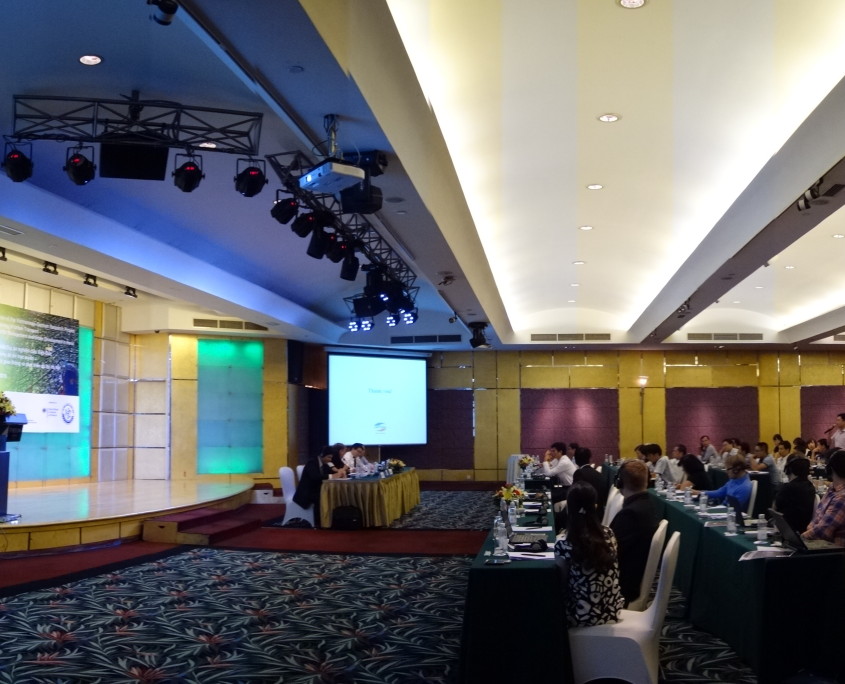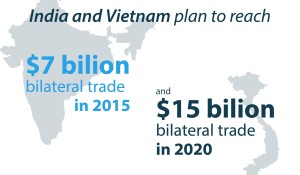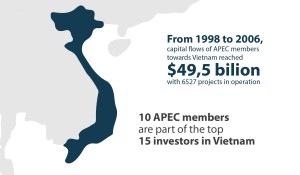In a previous post, we explored Vietnam’s economic context in the region and the world but here is a quick rundown of local current and proposed multi-party agreements that Vietnam is part of:
East Asian Summit (EAS)—annual forum on energy and trade held since 2005 between 18 countries.
Regional Comprehensive Economic Partnership (RCEP)—proposed free trade agreement between ASEAN members and Free Trade Agreement partners; formally launched in 2012 at the ASEAN summit. (China’s version of the proposed TPP.)
Asia-Pacific Economic Cooperation (APEC)—21 member Pacific Rim forum that was established in 1989. Membership is determined by economy, not country.
Association of Southeast Asian Nations (ASEAN)—formed in 1967, its membership today includes ten countries and focuses on political and economic issues.
And then there is the Trans-Pacific Partnership (TPP); this week we are going to do a roundup of some of the competing narratives when it comes to the TPP. The TPP has been in the works since 2002 (under a different name) with the US and Vietnam joining the round of talks in 2008. The twelve countries involved in the TPP comprise approximately 40% of global GDP; those countries are Brunei, Japan, Malaysia, Singapore, New Zealand, Australia, Mexico, Canada, Chile, Peru, and, of course, Vietnam and the US.
The TPP is both an economic and a strategic agreement; one thing to keep in mind is the annual GDP of Vietnam: approximately $170 billion. To put that in perspective, the annual revenue of General Electric is approximately $150 billion. In other words, the revenue of one US company is almost on parity with the annual GDP of Vietnam so there are other reasons than purely economic interest in Vietnam.
At a time when China is creating competing regional and global financial organizations, according to The New Yorker, such as “the New Development Bank, the Silk Road infrastructure fund, and the Asia Infrastructure Investment Bank, which, together, intend to amass two hundred and forty billion dollars in capital” (in association with some US allies) the US needs the TPP (or something like it) to pass in the near future to provide a counterbalance (as proponents of the TPP have argued).
In Favor of the TPP
What are the governments behind the TPP saying? Let’s start with some of the countries that are involved in the TPP negotiations (more than 20 rounds so far).
According to the Office of the US Trade Representative:
“As the cornerstone of the Obama Administration’s economic policy in the Asia Pacific, the Trans-Pacific Partnership reflects the United States’ economic priorities and values. The TPP not only seeks to provide new and meaningful market access for American goods and services exports, but also set high-standard rules for trade, and address vital 21st-century issues within the global economy.”
According to the Australian Department of Foreign Affairs and Trade:
“Conclusion of the TPP would open new trade and investment opportunities for Australia in the Asia-Pacific region, further integrate our economy in this fast growing region, and promote and facilitate regional supply chains. By setting commonly agreed rules and promoting transparency of new laws and regulations, the agreement will provide certainty for businesses and reduce costs and red tape for Australian exporters, service suppliers and investors.”
According to the New Zealand Ministry of Foreign Affairs & Trade:
“As well as tangible benefits for our exporters and consumers, TPP would safeguard New Zealand’s longer term trading interests. TPP is potentially a platform for wider, regional economic integration.”
According to the Foreign Affairs, Trade and Development Canada:
“Along with our successfully-concluded free trade agreement with Korea, our ongoing bilateral talks with Japan, and other ongoing initiatives, the TPP is a means to achieve our ambitious pro-trade, pro-export plan to create jobs and opportunities for hardworking Canadians.”
Against the TPP
What about the TPP’s skeptics?
There has been a great deal of secrecy surrounding the terms of the deal and some controversy. For example, China isn’t included in the deal and most of the information that the public knows about the TPP has been due to leaks.
According to Public Citizen:
“We only know about the TPP’s threats thanks to leaks – the public is not allowed to see the draft TPP text. Even members of Congress, after being denied the text for years, are now only provided limited access. Meanwhile, more than 500 official corporate “trade advisors” have special access. The TPP has been under negotiation for six years, and the Obama administration wants to sign the deal this year.”
MSF (Doctors without Borders) is against the TPP:
“Proposed by U.S. negotiators, the IP rules enhance patent and data protections for pharmaceutical companies, dismantle public health safeguards enshrined in international law, and obstruct price-lowering generic competition for medicines.”
Nobel economist and professor at Columbia University, Joseph Stiglitz, made the case against the same drug provisions in the TPP:
“The efforts to raise drug prices in the T.P.P. take us in the wrong direction. The whole world may come to pay a price in the form of worse health and unnecessary deaths.”
The EFF (Electronic Frontier Foundation) is against the TPP:
“TPP raises significant concerns about citizens’ freedom of expression, due process, innovation, the future of the Internet’s global infrastructure, and the right of sovereign nations to develop policies and laws that best meet their domestic priorities. In sum, the TPP puts at risk some of the most fundamental rights that enable access to knowledge for the world’s citizens.”
Former US secretary of Labor, Robert Reich is against “fast-tracking” the TPP (under the Trade Promotion Authority) and identifies some issues that the TPP overlooks:
“We need trade agreements that address unfair trade practices such as currency manipulation, foreign subsidies to exports, corporate power grabs and systematic and egregious violation of internationally recognized labor rights.”
Fast-tracking is important because it allows Congress to approve (or disapprove) the TPP as a whole, instead of introducing amendments which would surely kill the TPP in its entirety. (Senate Majority Leader Mitch McConnell from Kentucky is among those who want to pass the Trade Promotion Authority.)
Senator Elizabeth Warren of Massachusetts is against the TPP, in particular “Investor-State Dispute Settlement,” or ISDS:
“[I]f a Vietnamese company with U.S. operations wanted to challenge an increase in the U.S. minimum wage, it could use ISDS. But if an American labor union believed Vietnam was allowing Vietnamese companies to pay slave wages in violation of trade commitments, the union would have to make its case in the Vietnamese courts.”
The CATO Institute mostly agrees with her.
Senator Bernie Sanders of Vermont is also against the TPP:
“The TPP would make it easier for countries like Vietnam to export contaminated fish and seafood into the U.S. The FDA has already prevented hundreds of seafood imports from TPP countries because of salmonella, e-coli, methyl-mercury and drug residues. But the FDA only inspects 1-2 percent of food imports and will be overwhelmed by the vast expansion of these imports if the TPP is agreed to.”
(Here is a speech Senator Sanders gave to the Senate earlier this year.)
Both sides are very clear in their respective positions; there does not seem to be much middle ground. On one hand, governments and corporations are overwhelmingly in favor of passing the TPP. However, NGOs along with current and former politicians, policy advisers, and pro-consumer advocacy groups have all voiced their concerns about elements of the TPP.
Defining Failure and Success
So there are clear and credible opponents to the TPP. However, if the TPP fails, it could mean disastrous results for American foreign policy in the region.
As The Economist points out:
“Failure to complete it would be a terrible blow to American interests, for a number of reasons. Trade liberalisation itself is of course one. With prospects of a global agreement at the World Trade Organisation vanishing, America’s hopes lie in the TPP and the more distant Transatlantic Trade and Investment Partnership with Europe. In his state-of-the-union speech to Congress in January, Barack Obama dwelt on “the world’s fastest-growing region”, ie, Asia and the Pacific.”
As The Editors of the Bloomberg View pointed out:
“The main harm, if the talks fall apart, is the damage this would cause to the larger process of global economic integration.”
(However, a Bloomberg View columnist also covered secrecy issues involving the TPP process.)
The Brookings Institution laid out one scenario as a result of a failed TPP:
“The rebalance to Asia will stall. TPP is the second leg (after a reorientation of military resources) of the policy of rebalancing to Asia. As such, its fate will determine whether this strategy advances or just limps along. If TPP fails, doubts about the staying power of the United States will once again rear their ugly head. The signature U.S. policy to remain vitally connected to the world’s most dynamic economic region will come to naught. Let’s not forget that prior to the advent of TPP, the United States appeared poised to be marginalized from the process of regionalism in Asia.”
And if the TPP passes then what would that mean for the average American?
According to Moyers & Company, the TPP will drastically impact income distribution in the US:
“[T]he incomes of those at the very bottom of the ladder would be protected by the minimum wage, and those at the very top would benefit significantly from the deal’s intellectual property and investment protections. But the vast majority of Americans would see their incomes drop.”
Rep. Loretta Sanchez of California goes further to elaborate how destructive the TPP would be for the US and its workers:
“Unfortunately, the TPP would neither ‘protect American workers’ nor bring jobs ‘back from China.’ Assessing what we know of the massive TPP only affirms what we’ve learned the hard way through past broken promises on trade pacts – it’s a bad deal for American workers.”
And what about the ISDS?
Jeffrey Zients, Director of the National Economic Council, wrote on the White House Blog:
“There have only been 13 cases brought to judgment against the United States in the three decades since we’ve been party to these [kinds of] agreements. By contrast, during the same period of time in our domestic system, individual and companies have brought hundreds of thousands of challenges against Federal, state, and local governments in U.S. courts under U.S. law.
We have never lost an ISDS case because of the strong safeguards in the U.S. approach.”
But that doesn’t mean that the US will always win an ISDS in the future either.
Time is Running Out
So who is right and who is wrong? Can both sides be right? What should be done?
American workers can’t compete on labor wages alone and workers (in general) can’t compete against automation. Is it better to get rid of vulnerable (to outsourcing) American jobs now that will eventually be lost to job automation?
Who would benefit the most from the TPP? What sort of timeframe are we looking at? Five years down the road? 10 years? 20? Through that lens, who is really winning and who is losing? It’s only with hindsight that we can see the effects of NAFTA.
Are there other issues that have been overlooked and that the TPP would open the floodgates for?
In the short term, the TPP would make Vietnam a clear winner (as a result of its growing manufacturing base) but the benefits for the majority of Americans seems limited and largely focused on American corporations. Mexico would benefit as well, especially if Vietnam were to slash its high import taxes on vehicles. However, as we pointed out in this post, cheap labor is not a sustainable competitive advantage for Vietnam in the long term.
However, the effects of the TPP will surely be felt beyond Vietnam, the US, and the 10 other countries involved. In a sense, international trade, intellectual property rights, and fundamental issues of national sovereignty in the 21st century will all be redefined. The lack of transparency in the process, the unanswered questions, and the overall unclear picture does little to bolster confidence in those who are promoting the TPP in a positive light.
If the TPP fails to go through, it would deal a serious blow to American efforts in Asia. The TPP is in a fragile state at the moment; it can be derailed if Congress does not grant Trade Promotion Authority. Trade Promotion Authority (TPA) means that Congress can approve or disapprove the TPP but cannot amend or filibuster. The TPA must be obtained from Congress first in order to “fast-track” the TPP, i.e., to give a “yes” or “no” vote as President Obama has requested. The US expects TPA to pass within the next month but it’s not a done deal.
The LA Times recently summed up the state of negotiations:
“At this point, the administration appears to have pinned its hopes on a fast-track bill being negotiated by Sen. Ron Wyden of Oregon, the Democrats’ top member of the Finance Committee. Fast-track authority is also supported by the committee chairman, Sen. Orrin G. Hatch (R-Utah), and Ryan in the House.
But the administration’s strategy looks in peril as talks between Wyden and the others have dragged on.”
Simply put, without TPA, there is no TPP, (and less “rebalancing” to Asia) but perhaps that’s a good thing in the long term.
Former IMF chief economist Simon Johnson, and Representative Sander Levin of Michigan posed a profound question about the TPP in Politico Magazine:
“Are the agreement’s rules sufficiently forward-looking and strong enough to bring about meaningful lasting improvements to people’s lives, by enhancing the positive aspects and addressing the negative impacts of globalization?”
As more information about the TPP’s 26 chapters continues to leak to the public, the answer to that question seems to be a resounding “no.”
























